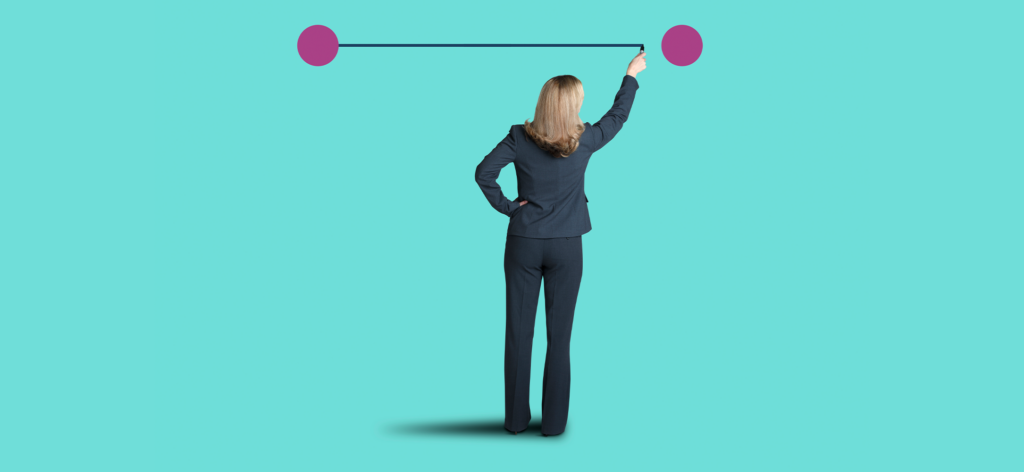Marketers can use customer journey orchestration to align physical and digital touch points, improving customer loyalty, retention, return on ad spend, and the overall customer experience.
Today’s customer journey is more complex than ever, and takes place across more channels than ever before.
Digital-first customers may be interacting with your brand through display advertising, social media, online, in-person, or through a call center. Marketers, sales, and customer service teams need to be able to combine both physical and digital customer data to understand the customer journey better across all channels quickly and easily.
In order to manage the full customer journey effectively, marketers must have a deep understanding of their customers across all touch points persistently over time. Marketers who plan and execute traditional push marketing campaigns are challenged to glean in-depth insights into their customers’ wants and needs, in real time. This can lead to less-than-ideal results when looking at metrics like return on ad spend (ROAS) and lifetime customer value.
Customer journey orchestration enables marketers to plan out the customer journey so they can deliver contextual messaging through the right channels, at the right time. Until you define customer journeys across multiple scenarios, you really won’t be able to understand in-depth how customers and prospects engage with your business.
While there are many tools and solutions that can help manage and orchestrate the customer journey, customer data platforms (CDPs) are designed to gather and integrate customer data from multiple disparate data silos to create a single customer view. Some enterprise-grade CDPs also have journey orchestration capabilities integrated into the platform, giving marketers additional ability to identify, segment, and orchestrate personalized customer journeys for distinct audiences in near real time.
What is the Customer Journey?
A customer journey is the full lifecycle of the relationship between an organization and an individual customer. Rather than focusing on a single transaction or event, the customer journey represents the full duration of a customer’s engagement with a brand across multiple interactions. The customer journey goes across every touch point – from awareness to acquisition, to loyalty and advocacy.
While customer journeys are related to the overall customer experience, the two terms are not interchangeable. The customer journey refers to the actual interaction – both physical and digital – between a customer and a business. Customer experience refers to how a customer feels about your company and its brand based on those interactions over time.
What is Customer Journey Mapping?
Customer journey maps deliver actionable insights on how people become aware of your brand, what makes them convert or transact with you, why they leave, and why they come back. Through customer journey mapping, marketers can visualize the entire customer journey.
A customer journey needs to be documented and mapped to be useful when creating orchestrated journeys. There are a variety of different types of customer journey maps, and processes to create a customer journey map. Choosing the right approach will be dependent on your business goals. Check out our guide here to learn more about the process, and how to create a custom customer journey map for your organization.
How Does Customer Journey Orchestration Work?
Customer journey orchestration allows marketing teams to plan and analyze the customer journey. Journey orchestration can also include predictive modeling to determine the next-best action that will most likely to lead to the desired result.
Customer journey orchestration personalizes the customer experience through relevancy. For example, if a customer recently attended several product-focused webinars, AI-driven journey orchestration can follow up with relevant content based on their interest in the event or product. This better unites efforts across teams for a seamless customer journey.
Technology Used in Customer Journey Orchestration
There are two options to power customer journey orchestration: a dedicated customer journey orchestration engine, or a broader platform with integrated journey orchestration.
An engine will connect to your customer data sources such as a customer relationship management (CRM) or customer data platform (CDP), analyzing the data to determine an optimal, personalized next step for each potential customer and their journey. It also connects to end-points to provide that step, such as sending an email or a push notification through a mobile app.
Customer Journey Orchestration with a CDP
The other option is to use a CDP that has journey orchestration capabilities included. This can reduce costs associated with your technology stack by using one platform. It can also lessen the chance of inconsistencies or issues with the integrity of the data by eliminating the need for separate platforms to house customer data and perform journey orchestration.
With a CDP that has customer journey orchestration capabilities, marketers can orchestrate a customer journey across both physical and digital touch points to improve customer loyalty, retention, return on ad spend, and the overall customer experience.
By using a CDP to analyze customer data, marketers can find out what traits are common to their most valuable customers, which customers are likely to buy soon or require further nurturing, and which customers are likely to churn. Artificial intelligence (AI) and machine learning (ML) algorithms can be applied to surface next-best action recommendations, which help marketers identify how to best move customers through the path of purchase based on their wants, needs, or preferences.
Getting Started with Customer Journey Orchestration
Every buyer’s journey is unique and personal. Personalizing the customer journey requires customer-centric positioning across touch points, along with investment in the technology, skills, talent, processes, and infrastructure needed to execute customer journey orchestration successfully.
Defining what customer centricity means to your organization means establishing consistent, relevant, and personalized experiences for customers. Deploying the right technology platforms and tools are critical for success.
A CDP, equipped with AI/ML for segmentation and orchestration, can be used to automate customer journey management, giving organizations insights about customer behaviors that enable them to tailor the customer experience at different stages of the customer journey.



